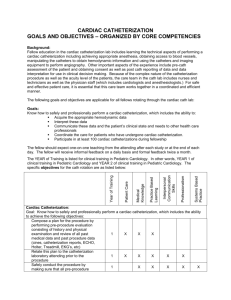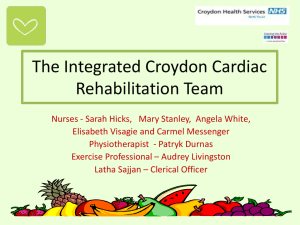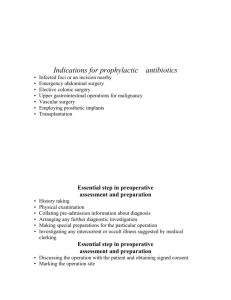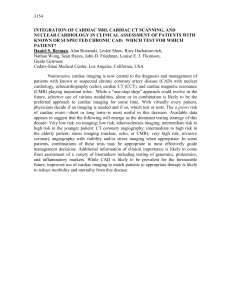section .1600 – criteria and standards for cardiac catheterization
advertisement
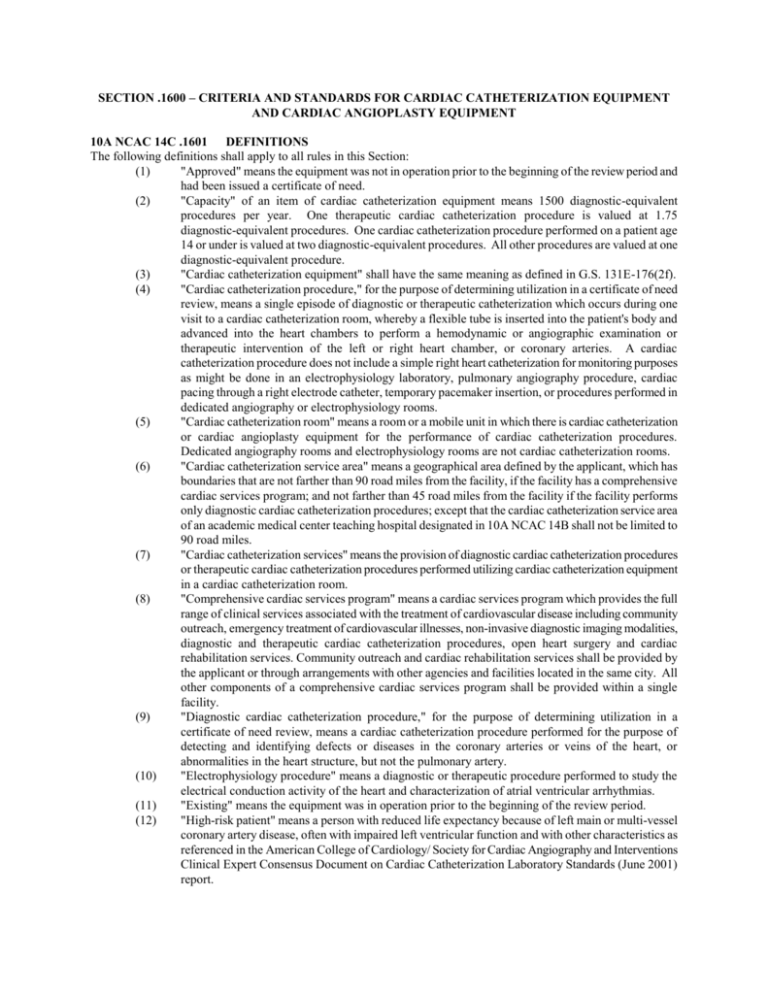
SECTION .1600 – CRITERIA AND STANDARDS FOR CARDIAC CATHETERIZATION EQUIPMENT AND CARDIAC ANGIOPLASTY EQUIPMENT 10A NCAC 14C .1601 DEFINITIONS The following definitions shall apply to all rules in this Section: (1) "Approved" means the equipment was not in operation prior to the beginning of the review period and had been issued a certificate of need. (2) "Capacity" of an item of cardiac catheterization equipment means 1500 diagnostic-equivalent procedures per year. One therapeutic cardiac catheterization procedure is valued at 1.75 diagnostic-equivalent procedures. One cardiac catheterization procedure performed on a patient age 14 or under is valued at two diagnostic-equivalent procedures. All other procedures are valued at one diagnostic-equivalent procedure. (3) "Cardiac catheterization equipment" shall have the same meaning as defined in G.S. 131E-176(2f). (4) "Cardiac catheterization procedure," for the purpose of determining utilization in a certificate of need review, means a single episode of diagnostic or therapeutic catheterization which occurs during one visit to a cardiac catheterization room, whereby a flexible tube is inserted into the patient's body and advanced into the heart chambers to perform a hemodynamic or angiographic examination or therapeutic intervention of the left or right heart chamber, or coronary arteries. A cardiac catheterization procedure does not include a simple right heart catheterization for monitoring purposes as might be done in an electrophysiology laboratory, pulmonary angiography procedure, cardiac pacing through a right electrode catheter, temporary pacemaker insertion, or procedures performed in dedicated angiography or electrophysiology rooms. (5) "Cardiac catheterization room" means a room or a mobile unit in which there is cardiac catheterization or cardiac angioplasty equipment for the performance of cardiac catheterization procedures. Dedicated angiography rooms and electrophysiology rooms are not cardiac catheterization rooms. (6) "Cardiac catheterization service area" means a geographical area defined by the applicant, which has boundaries that are not farther than 90 road miles from the facility, if the facility has a comprehensive cardiac services program; and not farther than 45 road miles from the facility if the facility performs only diagnostic cardiac catheterization procedures; except that the cardiac catheterization service area of an academic medical center teaching hospital designated in 10A NCAC 14B shall not be limited to 90 road miles. (7) "Cardiac catheterization services" means the provision of diagnostic cardiac catheterization procedures or therapeutic cardiac catheterization procedures performed utilizing cardiac catheterization equipment in a cardiac catheterization room. (8) "Comprehensive cardiac services program" means a cardiac services program which provides the full range of clinical services associated with the treatment of cardiovascular disease including community outreach, emergency treatment of cardiovascular illnesses, non-invasive diagnostic imaging modalities, diagnostic and therapeutic cardiac catheterization procedures, open heart surgery and cardiac rehabilitation services. Community outreach and cardiac rehabilitation services shall be provided by the applicant or through arrangements with other agencies and facilities located in the same city. All other components of a comprehensive cardiac services program shall be provided within a single facility. (9) "Diagnostic cardiac catheterization procedure," for the purpose of determining utilization in a certificate of need review, means a cardiac catheterization procedure performed for the purpose of detecting and identifying defects or diseases in the coronary arteries or veins of the heart, or abnormalities in the heart structure, but not the pulmonary artery. (10) "Electrophysiology procedure" means a diagnostic or therapeutic procedure performed to study the electrical conduction activity of the heart and characterization of atrial ventricular arrhythmias. (11) "Existing" means the equipment was in operation prior to the beginning of the review period. (12) "High-risk patient" means a person with reduced life expectancy because of left main or multi-vessel coronary artery disease, often with impaired left ventricular function and with other characteristics as referenced in the American College of Cardiology/ Society for Cardiac Angiography and Interventions Clinical Expert Consensus Document on Cardiac Catheterization Laboratory Standards (June 2001) report. (13) (14) (15) (16) History Note: "Mobile equipment" means cardiac catheterization equipment and transporting equipment which is moved to provide services at two or more host facilities. "Percutaneous transluminal coronary angioplasty (PTCA)" is one type of therapeutic cardiac catheterization procedure used to treat coronary artery disease in which a balloon-tipped catheter is placed in the diseased artery and then inflated to compress the plaque blocking the artery. "Primary cardiac catheterization service area" means a geographical area defined by the applicant, which has boundaries that are not farther than 45 road miles from the facility, if the facility has a comprehensive cardiac services program; and not farther than 23 road miles from the facility if the facility performs only diagnostic cardiac catheterization procedures; except that the primary cardiac catheterization service area of an academic medical center teaching hospital designated in 10A NCAC 14B shall not be limited to 45 road miles. "Therapeutic cardiac catheterization procedure," for the purpose of determining utilization in a certificate of need review, means a cardiac catheterization procedure performed for the purpose of treating or resolving anatomical or physiological conditions which have been determined to exist in the heart or coronary arteries or veins of the heart, but not the pulmonary artery. Authority G.S. 131E-177(1); 131E-183; Eff. January 1, 1987; Temporary Amendment Eff. September 1, 1993 for a period of 180 days or until the permanent rule becomes effective, whichever is sooner; Amended Eff. November 1, 1996; February 1, 1994; Temporary Amendment Eff. January 1, 1999; Temporary Eff. January 1, 1999 Expired on October 12, 1999; Temporary Amendment Eff. January 1, 2000; Temporary Amendment effective January 1, 2000 amends and replaces a permanent rulemaking originally proposed to be effective August 1, 2000; Temporary Amendment Eff. January 1, 2001; Temporary Amendment effective January 1, 2001 amends and replaces a permanent rulemaking originally proposed to be effective April 1, 2001; Amended Eff. August 1, 2002; Temporary Amendment Eff. February 1, 2006; Amended Eff. November 1, 2006.
